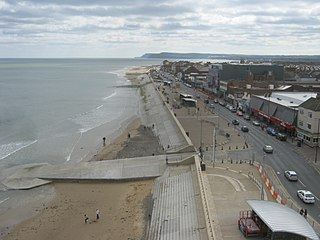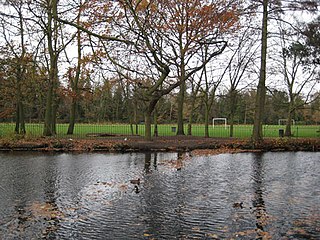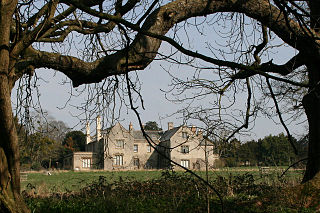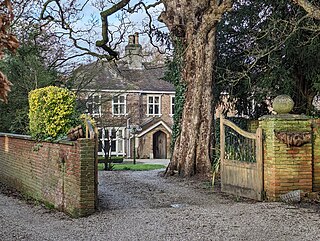
Belton House is a Grade I listed country house in the parish of Belton near Grantham in Lincolnshire, England, built between 1685 and 1687 by Sir John Brownlow, 3rd Baronet. It is surrounded by formal gardens and a series of avenues leading to follies within a larger wooded park. Belton has been described as a compilation of all that is finest of Carolean architecture, said to be the only truly vernacular style of architecture that England had produced since the Tudor period. It is considered to be a complete example of a typical English country house; the claim has even been made that Belton's principal façade was the inspiration for the modern British motorway signs which give directions to stately homes.

Redcar and Cleveland is a unitary authority area with borough status in North Yorkshire, England.

Sutton Park is an 18th-century Georgian English country house situated on the edge of the village of Sutton-on-the-Forest, North Yorkshire. It is approximately 10 miles north of York, in the ancient Forest of Galtres. The house, a Grade I listed building, is open to the public for part of the year. It is the residence of Sir Reginald Sheffield, 8th Baronet, and Lady Sheffield.

Royal Lodge is a Grade II listed house in Windsor Great Park in Berkshire, England, half a mile north of Cumberland Lodge and 3.2 miles (5.1 km) south of Windsor Castle. Part of the Crown Estate, it was the Windsor residence of Queen Elizabeth The Queen Mother from 1952 until she died there in 2002, at the age of 101. In 2004 it became the official country residence of Prince Andrew, Duke of York, and his family. In 2023 it was reported that Andrew had been offered the smaller five-bedroom Frogmore Cottage instead, until then the UK residence of Prince Harry, Duke of Sussex and his family, who were requested to vacate by Buckingham Palace.

Elsham Hall is a 17th-century English country house situated in its own parkland in Elsham, North Lincolnshire. The park and gardens are open to the public.

Muncaster Castle is a privately owned castle overlooking the River Esk, about a mile east of the west-coastal town of Ravenglass in Cumbria, England. It is recorded in the National Heritage List for England as a designated Grade I listed building.

Freemasons' Hall in London is the headquarters of the United Grand Lodge of England and the Supreme Grand Chapter of Royal Arch Masons of England, as well as being a meeting place for many Masonic Lodges in the London area. It is located in Great Queen Street between Holborn and Covent Garden and has been a Masonic meeting place since 1775.
Gilling Castle is a Grade I listed country house near Gilling East, North Yorkshire, England.

Compton Verney House is an 18th-century country mansion at Compton Verney near Kineton in Warwickshire, England. It is located on the west side of a lake north of the B4086 about 12 miles (19 km) north-west of Banbury. Today, it is the site of the Compton Verney Art Gallery.

Belair Park is a park located in the West Dulwich part of the London Borough of Southwark, southeast London, England. The park grounds once belonged to Belair House, a country villa built in Adam style that is now a Grade II listed building. There are also two other Grade II listed structures within the park: the lodge and entrance gate, and an old stable building.

Kinmel Hall is a large country mansion within Kimnel Park near the village of St. George, close to the coastal town of Abergele, in Conwy county borough, Wales. The hall, the third building on the site, was completed in the mid 19th century for the family of a Welsh mining magnate. In 1929, the property ceased being a private residence; it has since been used as a boys' school, health spa, girls' school, wartime hospital, conference centre and hotel.

Middleton Lodge is a Georgian Palladian mansion set within 200 acres (0.81 km2) of open countryside, on the outskirts of the village of Middleton Tyas, a mile or so off the A1 near Scotch Corner and a 15-minute drive from Darlington, County Durham.

Grantley Hall is an English country house located in North Yorkshire, England. It is situated near Grantley, about 5 miles (8 km) to the west of Ripon, on the banks of the River Skell. It is listed Grade II* on the National Heritage List for England, and the Japanese garden at the hall is listed Grade II on the Register of Historic Parks and Gardens.

Poundisford Park north of Pitminster, Somerset, England is an English country house that typifies progressive housebuilding on the part of the West Country gentry in the mid-16th century. The main house was built for William Hill around 1550 and has been designated as a Grade I listed building.

Hutton in the Forest is a Grade I listed country house near the village of Skelton in the historic county of Cumberland, which now forms part of the modern county of Cumbria, England. It belonged to the Fletcher-Vane family from 1605 until 1931 when it became the property of the Barons Inglewood who were distant relatives of the Fletcher-Vane family.

Skelton Castle can refer to either a ruined medieval castle or an 18th-century Gothic style country house that replaced it. The site of both buildings is the village of Skelton, in North Yorkshire, England. The house is Grade I listed.

Underley Hall is a large country house near Kirkby Lonsdale in Cumbria. It was designed in a Jacobean Revival style by the architect George Webster for Alexander Nowell and built between 1825 and 1828, on the site of an earlier house. An additional wing and tower, designed by E. G. Paley and Hubert Austin, were added in 1874.

The Lowbridge Estate is a country estate of approximately 2000 acres in the Lake District region of England that was in the continuous ownership of the Fothergill family from 1761. Lowbridge House, the principal house on the estate, was built in the 1830s by Richard Fothergill II (1789–1851) in the cottage orné style. The property was substantially updated and improved in 1889 and again in 2017 to 2019. The property lies between Todd Crag and Bannisdale. Other properties on the Estate include Lowbridge Cottage, Lowbridge Lodge and the Bridge House. The Estate has become a haven for red squirrels with a very active policy of conservation including the extensive planting of red squirrel friendly larch trees and the reintroduction of pine-martins.

St Giles' Church is the parish church of Skelton, a village in the rural northern part of the City of York.

Skelton Manor is a historic house in the village of Skelton, in the rural northern part of the City of York, in England.



















